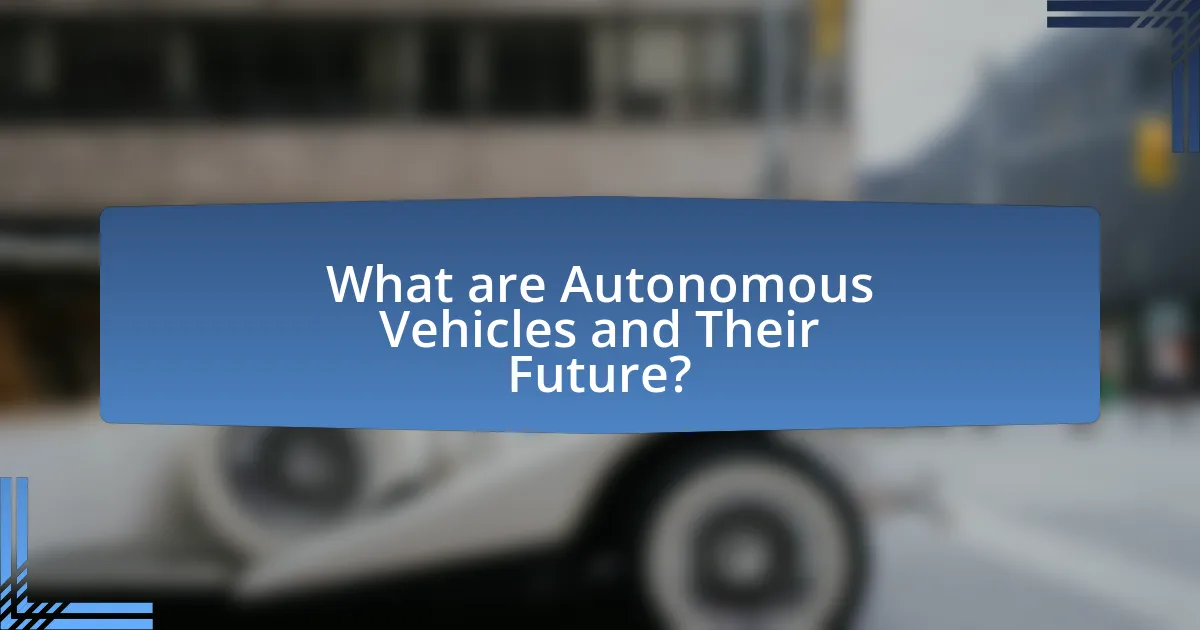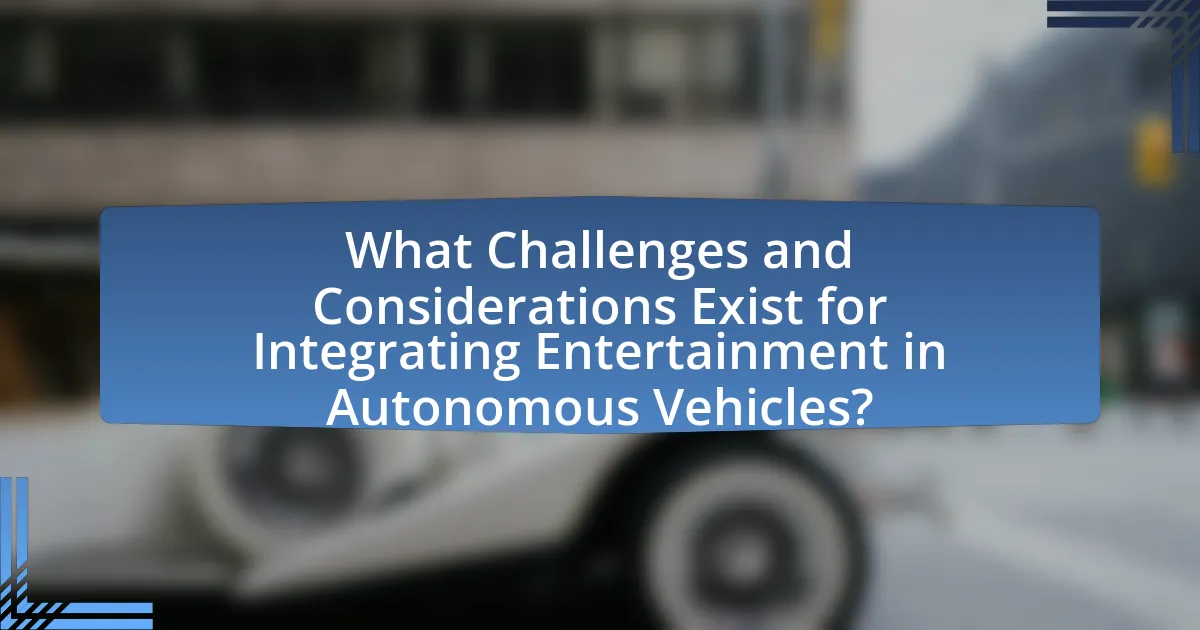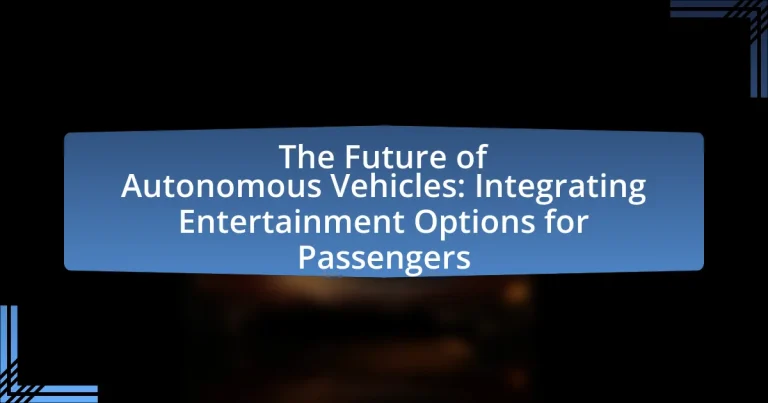Autonomous vehicles, or self-driving cars, are equipped with advanced technology that enables them to operate without human intervention. The article explores the future of these vehicles, highlighting the projected growth of the autonomous vehicle market, advancements in artificial intelligence and sensor technology, and the integration of entertainment options for passengers. Key topics include the operational mechanisms of autonomous vehicles, the role of consumer demand in shaping their development, regulatory impacts, and the potential societal changes resulting from their widespread adoption. Additionally, the article addresses the challenges and considerations for integrating entertainment systems, emphasizing the importance of user experience and safety in enhancing passenger satisfaction.

What are Autonomous Vehicles and Their Future?
Autonomous vehicles are self-driving cars equipped with technology that allows them to navigate and operate without human intervention. The future of these vehicles is poised for significant advancements, with projections indicating that by 2030, the global autonomous vehicle market could reach $557 billion, driven by improvements in artificial intelligence, sensor technology, and regulatory frameworks. As these vehicles become more prevalent, they are expected to integrate various entertainment options for passengers, transforming travel into a more enjoyable experience. This shift is supported by consumer demand for enhanced in-vehicle experiences, as studies show that 70% of passengers are interested in entertainment features during their journeys.
How do autonomous vehicles operate?
Autonomous vehicles operate using a combination of sensors, software, and artificial intelligence to navigate and control the vehicle without human intervention. These vehicles utilize technologies such as LIDAR, cameras, radar, and GPS to perceive their environment, detect obstacles, and make real-time decisions. For instance, LIDAR generates a 3D map of the surroundings, while cameras provide visual recognition of traffic signs and pedestrians. The onboard software processes this data to execute driving tasks, such as steering, acceleration, and braking, ensuring safe navigation. According to a report by the National Highway Traffic Safety Administration, autonomous vehicles have the potential to significantly reduce traffic accidents caused by human error, which accounts for approximately 94% of crashes.
What technologies enable the functionality of autonomous vehicles?
Autonomous vehicles rely on several key technologies for their functionality, including sensors, artificial intelligence, machine learning, and connectivity systems. Sensors such as LiDAR, radar, and cameras provide real-time data about the vehicle’s surroundings, enabling it to detect obstacles, lane markings, and traffic signals. Artificial intelligence processes this data to make driving decisions, while machine learning algorithms improve the vehicle’s performance over time by learning from past experiences. Connectivity systems, including V2X (vehicle-to-everything) communication, allow vehicles to interact with other vehicles and infrastructure, enhancing safety and efficiency. These technologies collectively enable autonomous vehicles to navigate complex environments safely and effectively.
How do sensors and AI contribute to vehicle autonomy?
Sensors and AI are critical components that enable vehicle autonomy by providing real-time data and decision-making capabilities. Sensors, such as LiDAR, cameras, and radar, collect information about the vehicle’s surroundings, including obstacles, road conditions, and traffic signals. This data is then processed by AI algorithms, which analyze the information to make driving decisions, such as navigation, speed control, and obstacle avoidance. For instance, a study by the National Highway Traffic Safety Administration found that vehicles equipped with advanced sensor systems can reduce accident rates significantly, demonstrating the effectiveness of these technologies in enhancing safety and reliability in autonomous driving.
What trends are shaping the future of autonomous vehicles?
Key trends shaping the future of autonomous vehicles include advancements in artificial intelligence, increased connectivity, and a focus on passenger experience. Artificial intelligence is enhancing decision-making capabilities, allowing vehicles to navigate complex environments more safely and efficiently. Increased connectivity through 5G technology enables real-time data exchange, improving traffic management and vehicle-to-vehicle communication. Additionally, the integration of entertainment options for passengers is becoming a priority, as companies recognize the importance of enhancing the in-vehicle experience during travel. According to a report by McKinsey & Company, the in-car entertainment market is projected to grow significantly, reflecting consumer demand for engaging content while commuting.
How is consumer demand influencing autonomous vehicle development?
Consumer demand is significantly influencing autonomous vehicle development by driving manufacturers to prioritize features that enhance user experience, including entertainment options. As consumers express a desire for vehicles that provide comfort and engagement during travel, companies are integrating advanced infotainment systems, connectivity features, and personalized content delivery. For instance, a survey by McKinsey & Company found that 70% of consumers are interested in entertainment options while commuting, prompting automakers to invest in technologies that cater to this demand. This shift not only shapes the design and functionality of autonomous vehicles but also accelerates the pace of innovation in the industry.
What role do regulations play in the advancement of autonomous vehicles?
Regulations play a crucial role in the advancement of autonomous vehicles by establishing safety standards and operational guidelines that ensure public trust and safety. These regulations help define the legal framework within which autonomous vehicles must operate, addressing issues such as liability, insurance, and data privacy. For instance, the National Highway Traffic Safety Administration (NHTSA) in the United States has issued guidelines that promote the safe testing and deployment of autonomous vehicles, which fosters innovation while ensuring that manufacturers adhere to safety protocols. Additionally, regulations can facilitate the integration of entertainment options for passengers by setting standards for in-vehicle technology and user experience, thereby enhancing the overall acceptance and functionality of autonomous vehicles in everyday life.
What are the potential impacts of autonomous vehicles on society?
Autonomous vehicles are expected to significantly transform society by enhancing road safety, reducing traffic congestion, and reshaping urban planning. Studies indicate that autonomous vehicles could reduce traffic accidents by up to 90% due to their advanced safety features and ability to communicate with each other. Additionally, the implementation of these vehicles may lead to decreased traffic congestion, as they can optimize driving patterns and reduce the need for parking spaces, potentially freeing up urban land for other uses. Furthermore, the integration of entertainment options for passengers in autonomous vehicles can enhance the travel experience, allowing individuals to engage in leisure activities while commuting. This shift could lead to changes in work-life balance and productivity, as people may utilize travel time more effectively.
How might autonomous vehicles change urban planning and infrastructure?
Autonomous vehicles will significantly alter urban planning and infrastructure by reducing the need for extensive parking spaces and enabling more efficient land use. As these vehicles can drop passengers off and park themselves in remote locations, cities can repurpose parking lots into green spaces, residential areas, or commercial developments. Research from the University of California, Berkeley, indicates that autonomous vehicles could decrease parking demand by up to 90%, allowing urban planners to redesign city layouts to prioritize pedestrian-friendly environments and public transit systems. This shift will lead to more sustainable urban ecosystems and improved quality of life for residents.
What are the implications for employment in the transportation sector?
The implications for employment in the transportation sector due to the rise of autonomous vehicles include significant job displacement and the creation of new roles. As autonomous technology advances, traditional driving jobs, such as truck drivers and taxi operators, are at risk of being automated, potentially leading to a loss of millions of jobs. For instance, a report by the American Trucking Associations estimates that over 3.5 million truck drivers could be affected. Conversely, the development and maintenance of autonomous systems will generate new employment opportunities in technology, engineering, and data analysis fields. The shift towards autonomous vehicles necessitates a workforce skilled in software development, cybersecurity, and vehicle maintenance, indicating a transformation in the types of jobs available in the sector.

How Can Entertainment Options Enhance the Passenger Experience in Autonomous Vehicles?
Entertainment options can significantly enhance the passenger experience in autonomous vehicles by providing engaging and personalized content during travel. These options can include streaming services, interactive games, and virtual reality experiences, which transform travel time into enjoyable leisure time. Research indicates that 70% of passengers prefer entertainment features in autonomous vehicles, as they help reduce boredom and anxiety associated with travel. Furthermore, integrating entertainment systems can lead to increased customer satisfaction and loyalty, as passengers feel more comfortable and entertained during their journeys.
What types of entertainment options can be integrated into autonomous vehicles?
Autonomous vehicles can integrate various entertainment options, including streaming services, video games, augmented reality experiences, and personalized audio content. Streaming services like Netflix and Spotify can provide passengers with on-demand movies, shows, and music, enhancing the travel experience. Video games can be played on built-in screens or through mobile devices, allowing for interactive entertainment during transit. Augmented reality experiences can offer immersive environments, transforming the vehicle’s interior into a gaming or educational space. Personalized audio content, such as podcasts or audiobooks, can cater to individual preferences, making journeys more enjoyable. These options are supported by advancements in connectivity and technology, enabling seamless access to entertainment while ensuring passenger safety and comfort.
How can streaming services be adapted for use in autonomous vehicles?
Streaming services can be adapted for use in autonomous vehicles by optimizing content delivery for passenger engagement and ensuring user-friendly interfaces. These adaptations include developing applications that allow for seamless streaming over in-vehicle Wi-Fi networks, utilizing high-speed internet connections to minimize buffering, and integrating voice-activated controls for hands-free operation. Additionally, services can offer personalized content recommendations based on user preferences and travel duration, enhancing the entertainment experience during commutes. Research indicates that 70% of consumers are interested in entertainment options while traveling in autonomous vehicles, highlighting the demand for such adaptations.
What role do gaming and virtual reality play in passenger entertainment?
Gaming and virtual reality significantly enhance passenger entertainment by providing immersive experiences that engage users during travel. These technologies allow passengers to escape the confines of their environment, offering interactive and captivating content that can transform the travel experience. For instance, a study by the International Air Transport Association (IATA) found that 70% of passengers prefer entertainment options that include gaming and virtual reality, indicating a strong demand for these features in transportation settings. Additionally, virtual reality can simulate real-world experiences, making long journeys more enjoyable and less monotonous, which is particularly beneficial in autonomous vehicles where passengers have more free time.
How do entertainment options affect passenger satisfaction?
Entertainment options significantly enhance passenger satisfaction by providing engagement and reducing perceived travel time. Research indicates that when passengers have access to diverse entertainment, such as movies, music, or interactive games, they report higher levels of enjoyment and comfort during their journey. A study published in the Journal of Transportation Research found that 78% of passengers felt more satisfied with their travel experience when entertainment options were available, as it helped alleviate boredom and stress associated with long trips. Thus, integrating varied entertainment options in autonomous vehicles can lead to improved overall passenger satisfaction.
What studies show the impact of entertainment on passenger comfort and enjoyment?
Studies indicate that entertainment significantly enhances passenger comfort and enjoyment in various transportation modes. For instance, research conducted by the University of Michigan Transportation Research Institute found that passengers in vehicles equipped with entertainment systems reported higher satisfaction levels and perceived comfort during travel. Additionally, a study published in the Journal of Transport and Health demonstrated that engaging entertainment options, such as movies or interactive games, can reduce travel-related stress and improve overall passenger experience. These findings underscore the importance of integrating entertainment options in autonomous vehicles to enhance passenger comfort and enjoyment.
How can personalized entertainment options improve the travel experience?
Personalized entertainment options can significantly enhance the travel experience by catering to individual preferences and needs, thereby increasing passenger satisfaction and engagement. For instance, studies show that when travelers have access to tailored content, such as movies, music, or games that align with their interests, they report higher levels of enjoyment and reduced perception of travel time. A survey conducted by the International Air Transport Association found that 70% of passengers prefer personalized entertainment during flights, indicating a strong demand for such services. By integrating these options into autonomous vehicles, companies can create a more enjoyable and immersive environment, ultimately transforming the way people perceive and experience travel.

What Challenges and Considerations Exist for Integrating Entertainment in Autonomous Vehicles?
Integrating entertainment in autonomous vehicles presents challenges such as safety, user experience, and technological limitations. Safety concerns arise from the need to ensure that entertainment systems do not distract passengers or interfere with the vehicle’s operation. User experience considerations include creating engaging content that is suitable for various demographics while maintaining comfort and accessibility. Technological limitations involve the need for robust connectivity and processing power to support high-quality entertainment options, which can be hindered by infrastructure and bandwidth issues. These challenges must be addressed to create a seamless and enjoyable entertainment experience in autonomous vehicles.
What are the technical challenges of providing entertainment in autonomous vehicles?
Providing entertainment in autonomous vehicles faces several technical challenges, including connectivity, safety, and user experience. Connectivity issues arise from the need for reliable internet access to stream content, which can be inconsistent in various locations. Safety concerns involve ensuring that entertainment systems do not distract the vehicle’s operation or compromise passenger safety during unexpected events. Additionally, user experience challenges include designing interfaces that are intuitive and accessible for passengers of all ages while accommodating different preferences and content types. These challenges must be addressed to create a seamless and enjoyable entertainment experience in autonomous vehicles.
How do connectivity issues affect streaming and gaming experiences?
Connectivity issues significantly disrupt streaming and gaming experiences by causing interruptions, buffering, and latency. These disruptions lead to a degraded user experience, where streaming services may pause to buffer or gaming sessions may lag, resulting in frustration for users. For instance, a study by Akamai Technologies found that a two-second delay in loading a video can lead to a 50% increase in abandonment rates. Additionally, high latency in online gaming can result in missed actions and decreased competitiveness, as players experience delays in their inputs being registered. Thus, reliable connectivity is essential for seamless streaming and gaming, directly impacting user satisfaction and engagement.
What safety concerns arise from passenger entertainment options?
Safety concerns arising from passenger entertainment options in autonomous vehicles include driver distraction, cybersecurity risks, and potential physical hazards. Driver distraction occurs when entertainment systems divert attention from the road, increasing the likelihood of accidents. Cybersecurity risks are significant as entertainment systems can be vulnerable to hacking, potentially compromising vehicle control and passenger safety. Additionally, physical hazards may arise from improperly secured devices or equipment that could become projectiles during sudden stops or collisions. These concerns highlight the need for stringent safety measures and regulations in the integration of entertainment options in autonomous vehicles.
How can manufacturers address these challenges?
Manufacturers can address the challenges of integrating entertainment options in autonomous vehicles by investing in advanced technology and user experience design. By utilizing high-speed internet connectivity and robust software platforms, manufacturers can ensure seamless streaming and interactive experiences for passengers. Research indicates that 70% of consumers prioritize in-car entertainment options, highlighting the demand for engaging content during travel. Additionally, collaboration with content providers can enhance the variety and quality of entertainment available, making the autonomous vehicle experience more appealing.
What innovations are being developed to enhance entertainment integration?
Innovations being developed to enhance entertainment integration in autonomous vehicles include advanced in-car streaming services, augmented reality (AR) experiences, and personalized content delivery systems. These technologies aim to transform the passenger experience by providing seamless access to a variety of entertainment options while traveling. For instance, companies like Tesla and Waymo are exploring partnerships with streaming platforms to enable passengers to watch movies or play games during their journeys. Additionally, AR applications are being designed to overlay digital content onto the real-world environment, creating immersive experiences that engage passengers. Research indicates that integrating these entertainment options can significantly improve passenger satisfaction and engagement, making travel more enjoyable and productive.
How can user feedback shape future entertainment offerings in autonomous vehicles?
User feedback can significantly shape future entertainment offerings in autonomous vehicles by providing insights into passenger preferences and behaviors. This feedback allows manufacturers and developers to tailor content, features, and interfaces that enhance user experience. For instance, surveys and usage data can reveal which types of media—such as movies, games, or music—are most popular among passengers, enabling companies to prioritize those options in their offerings. Additionally, real-time feedback mechanisms can facilitate immediate adjustments to entertainment systems, ensuring they remain relevant and engaging. Research indicates that companies that actively incorporate user feedback into product development see higher satisfaction rates and increased user engagement, demonstrating the importance of this approach in the evolving landscape of autonomous vehicle entertainment.
What best practices should be followed for integrating entertainment in autonomous vehicles?
To effectively integrate entertainment in autonomous vehicles, developers should prioritize user safety, seamless technology integration, and personalized content delivery. User safety is paramount; entertainment systems must not distract the vehicle’s operation or the passengers’ attention to their surroundings. Seamless technology integration involves ensuring that entertainment options are compatible with existing vehicle systems and can be easily accessed through intuitive interfaces. Personalized content delivery enhances user experience by utilizing data analytics to tailor entertainment choices based on individual preferences and travel patterns. These practices are supported by research indicating that user engagement increases when entertainment is relevant and easily accessible, thereby improving overall passenger satisfaction in autonomous vehicles.
How can manufacturers ensure a seamless user experience with entertainment options?
Manufacturers can ensure a seamless user experience with entertainment options by integrating user-friendly interfaces and personalized content delivery systems. By utilizing advanced technologies such as artificial intelligence and machine learning, manufacturers can analyze user preferences and behaviors to curate tailored entertainment experiences. For instance, a study by McKinsey & Company highlights that 70% of consumers prefer personalized content, which can significantly enhance user satisfaction in autonomous vehicles. Additionally, ensuring high-quality connectivity and low latency through robust internet solutions is crucial, as it allows for uninterrupted streaming and access to various entertainment platforms. This combination of personalized content and reliable connectivity directly contributes to a more enjoyable and engaging experience for passengers in autonomous vehicles.
What considerations should be made for diverse passenger demographics?
Considerations for diverse passenger demographics in autonomous vehicles include accessibility, cultural preferences, and age-specific needs. Accessibility ensures that features accommodate individuals with disabilities, such as wheelchair access and audio-visual aids. Cultural preferences involve offering entertainment options that reflect the diverse backgrounds of passengers, including language choices and content that resonates with various cultural contexts. Age-specific needs require attention to the interests and comfort levels of different age groups, from children to seniors, ensuring that entertainment options are engaging and appropriate for all. These considerations are essential for creating an inclusive and enjoyable experience for all passengers in autonomous vehicles.


